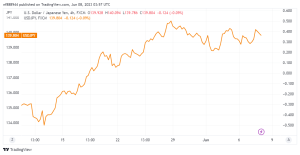USDJPY falls on Thursday, reversing some of the previous day’s gains.
The USDJPY pair struggles to capitalize on the overnight goodish bounce from the 139.00 level, or the weekly low. And encounters some supply throughout Thursday’s Asian session. Spot prices are now trading around 139.85, down about 0.20% on the day. While any substantial loss remains elusive.
The safe-haven Japanese Yen (JPY) benefits from speculation about more Bank of Japan (BoJ) interventions to strengthen the domestic currency. As well as the cautious market sentiment. Aside from that, a little US Dollar The downtick. In the US dollar puts some downward pressure on the USDJPY pair. However, uncertainty about the Federal Reserve’s (Fed) rate-hike path and rising. US Treasury bond rates may likely limit the buck’s fall, lending support to the major.
USDJPY Technical Outlook
Technically, the USDJPY pair has been bouncing in a range since the start of this week. Producing a rectangle on hourly charts. With a rise from the mid-133.00s, or the May monthly swing low. This may still be classified as a bullish consolidation period. Furthermore, spot prices have managed to stay above the 4-hour chart’s upward-sloping 100-period Simple Moving Average (SMA). Which favors bulls and increases expectations for additional rises.
Bullish Before putting new bets, traders should wait for acceptance over the 140.00. Psychological level and a sustained break of the 140.20-140.30 horizontal barrier.

The USDJPY pair may potentially accelerate its upward trend towards the YTD top, which was reached in May in the 140.90 zone. Some follow-through purchasing over the 141.00 level will be viewed as a new trigger for bullish traders, setting the scene for the pair to continue strengthening.
On the other hand, the 100-period SMA, which is now slightly ahead of the 139.00 round number, may continue to safeguard the immediate downside. A convincing break below 139.00 might spark some technical selling, dragging the USDJPY pair to a monthly low in the 138.45-138.40 range. The declining trend might be extended further towards the 138.00 level before spot prices drop to the 137.30 zone, which represents critical 200-day SMA support.








